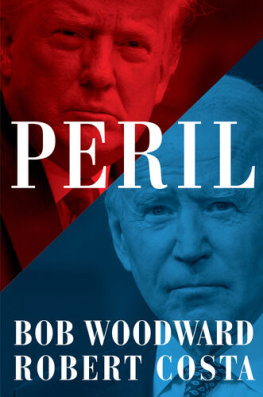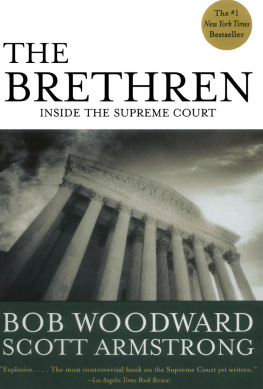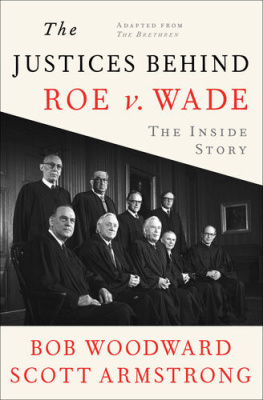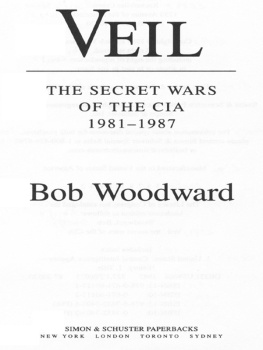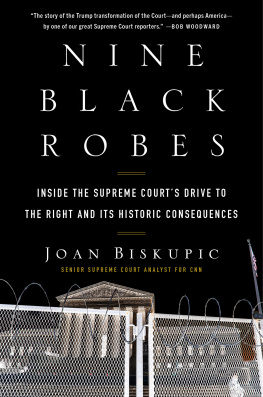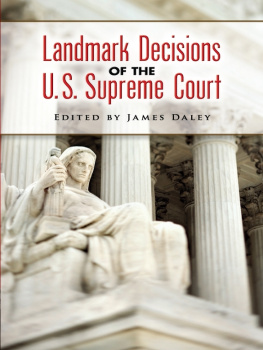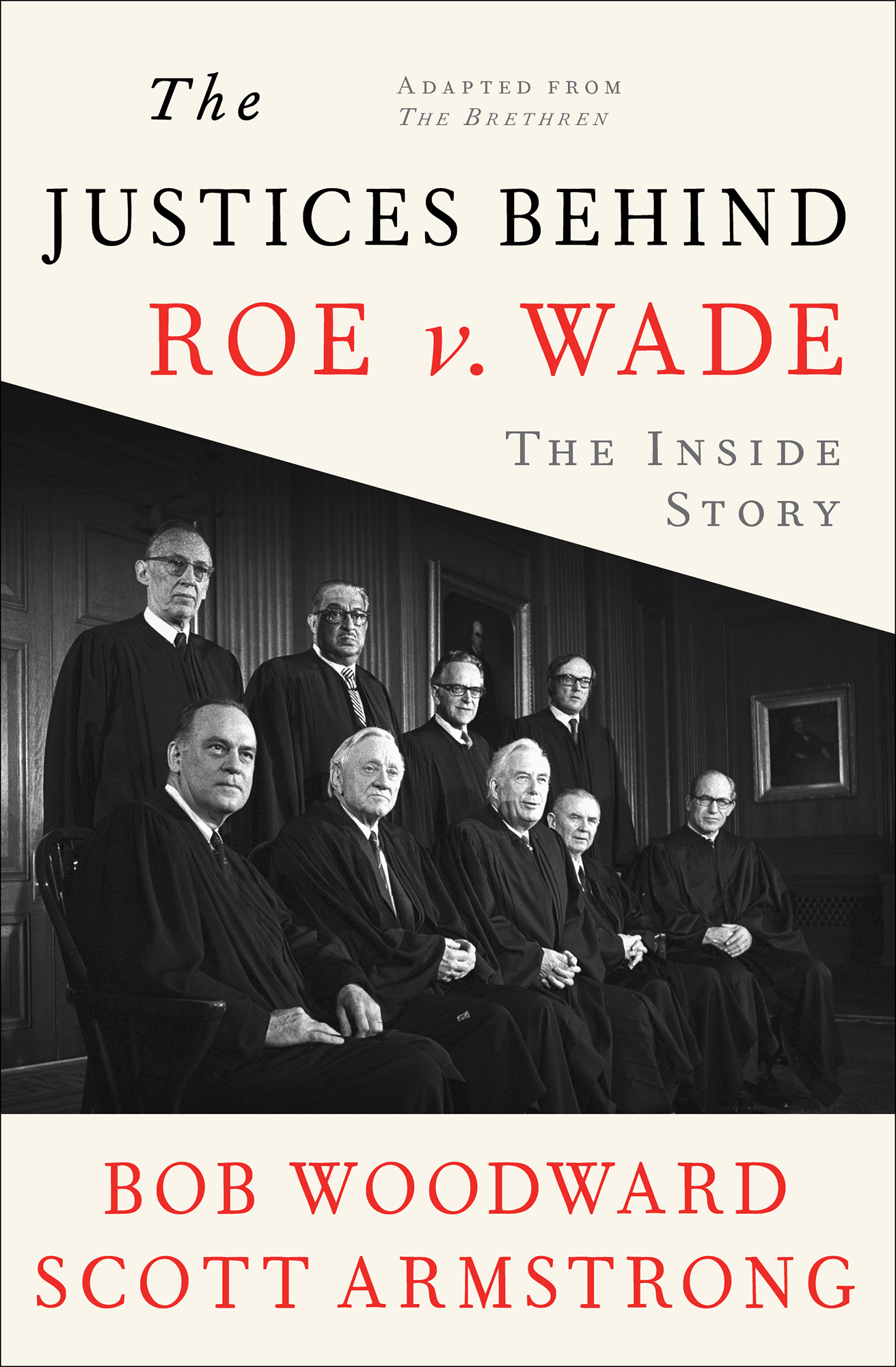The Justices Behind Roe v. Wade
Adapted from The Brethren
The Inside Story
Bob Woodward
Scott Armstrong
Praise for The Brethren
Explosive. The most controversial book on the Supreme Court yet written.
Los Angeles Times Book Review
Fascinating. The pace is swift, with details that rivet the attention.
The Washington Post Book World
A provocative book about a hallowed institution. It is the most comprehensive inside story ever written of the most important court in the world. For this reason alone it is required reading.
BusinessWeek
It is to the credit of Woodward and Armstrong that they were willingand ableto shatter this conspiracy of silence. It is certainly in the highest tradition of investigative journalism.
Saturday Review
One hell of a reporting achievement.
The Village Voice
The years best political book.
New York Post
Thank you for downloading this Simon & Schuster ebook.
Get a FREE ebook when you join our mailing list. Plus, get updates on new releases, deals, recommended reads, and more from Simon & Schuster. Click below to sign up and see terms and conditions.
CLICK HERE TO SIGN UP
Already a subscriber? Provide your email again so we can register this ebook and send you more of what you like to read. You will continue to receive exclusive offers in your inbox.
To Katharine Graham, Chairman of the Board, The Washington Post Company, for her unwavering commitment to an independent press and the First Amendment.
And to our children, Tali, Thane and Tracey
A court which is final and unreviewable needs more careful scrutiny than any other. Unreviewable power is the most likely to self-indulge itself and the least likely to engage in dispassionate self-analysis. In a country like ours, no public institution, or the people who operate it, can be above public debate.
Warren E. Burger, Circuit Court of Appeals Judge, to Ohio Judicial Conference on September 4, 1968nine months before being named Chief Justice of the United States
AUTHORS NOTE
Two people labored as long and as hard on this book as the authors.
Al Kamen, a former reporter for the Rocky Mountain News, assisted us in the reporting, writing and editing of this book. He was the chief negotiator and buffer between us. His thoroughness, skepticism and sense of fairness contributed immeasurably. No person has ever offered us as much intelligence, endurance, tact, patience and friendship.
Benjamin Weiser, now a reporter for The Washington Post, helped in the research, writing, editing and reporting. A devoted and resourceful assistant, no one could have been more loyal and trusted.
This book is as much theirs as ours.
INTRODUCTION
THE UNITED STATES SUPREME COURT, the highest court in the land, is the final forum for appeal in the American judiciary. The Court has interpreted the Constitution and has decided the countrys preeminent legal disputes for nearly two centuries. Virtually every issue of significance in American society eventually arrives at the Supreme Court. Its decisions ultimately affect the rights and freedom of every citizenpoor, rich, Black people, Indian people, pregnant women, those accused of crime, those on death row, newspaper publishers, pornographers, environmentalists, businessmen, baseball players, prisoners and presidents.
For those nearly 200 years, the Court has made its decisions in absolute secrecy, handing down its judgments in formal written opinions. The Courts deliberative processits internal debates, the tentative positions taken by the justices, the preliminary votes, the various drafts of written opinions, the negotiations, confrontations and compromisesis hidden from public view.
The Court has developed certain traditions and rules, largely unwritten, that are designed to preserve the secrecy of its deliberations. The few previous attempts to describe the Courts internal workingsbiographies of particular justices or histories of individual caseshave been published years, often decades, after the events, or have reflected the viewpoints of only a few justices.
Much of the history, notably the period that included the continued court-ordered desegregation of public schools, the Vietnam War, and the role of the states in regulating abortion, suggests that the detailed steps of decision making, the often hidden motives of the decision makers, can be as important as the eventual decisions themselves. Yet the Court, unlike the Congress and the presidency, has by and large escaped public scrutiny. And because its members are not subject to periodic reelection, but are appointed for life, the Court is less disposed to allow its decision making to become public. Little is usually known about the justices when they are appointed, and after taking office they limit their public exposure to the Courts published opinions and occasional, largely ceremonial, appearances.
The Justices Behind Roe v. Wade is an account of the inner workings of the Supreme Court from 1969 to 1973the first four years of Warren E. Burgers tenure as chief justice of the United States. However, it is not intended as a comprehensive review of all the important decisions made during the period.
The Court conducts its business during an annual session called a term, which begins each October and continues until the last opinion is announced in June or early July. The Court recess runs from then until the next October.
Normally, there are seven decision-making steps in each case the Court takes.
1. The decision to take the case requires that the Court note its jurisdiction or formally grant cert. Under the Courts procedures, the justices have discretion in selecting which cases they will consider. At least four of the nine justices must vote to hear a case. These votes are cast in a secret conference attended only by the justices, and the actual vote is ordinarily not disclosed.
2. Once the Court agrees to hear a case, it is scheduled for written and oral argument by the lawyers for the opposing sides. The written arguments, called legal briefs, are filed with the Court and are available to the public. The oral arguments are presented to the justices publicly in the courtroom; a half hour is usually allotted to each side.
3. A few days after oral arguments, the justices discuss the case at a closed meeting called the case conference. There is a preliminary discussion and an initial vote is taken. Like all appellate courts, the Supreme Court normally uses the facts already developed from testimony and information presented to the lower trial court. The Supreme Court can reinterpret the laws, the U.S. Constitution and prior cases. On this basis, the decisions of lower courts are affirmed or reversed. As in the cert conference, at which justices decide which cases to hear, only the justices attend the case conferences. (The nine members of the Court often refer to themselves collectively as the conference.)
4. The next crucial step is the selection of one of the nine justices to write a majority opinion. By tradition, the chief justice, if he is in the initial majority, can assign himself or another member of the majority to write the opinion. When he is not in the majority, the senior justice in the majority makes the assignment.

